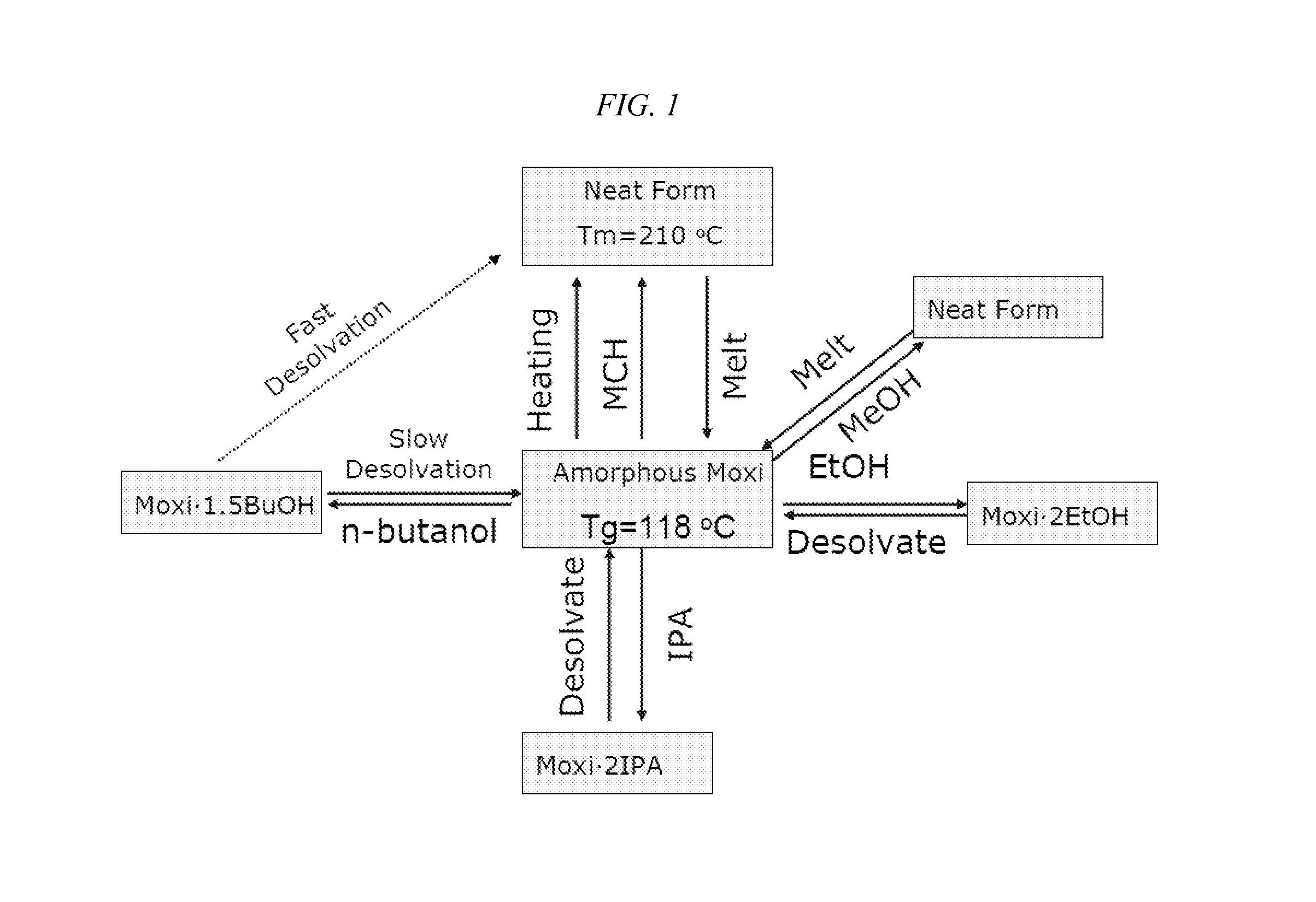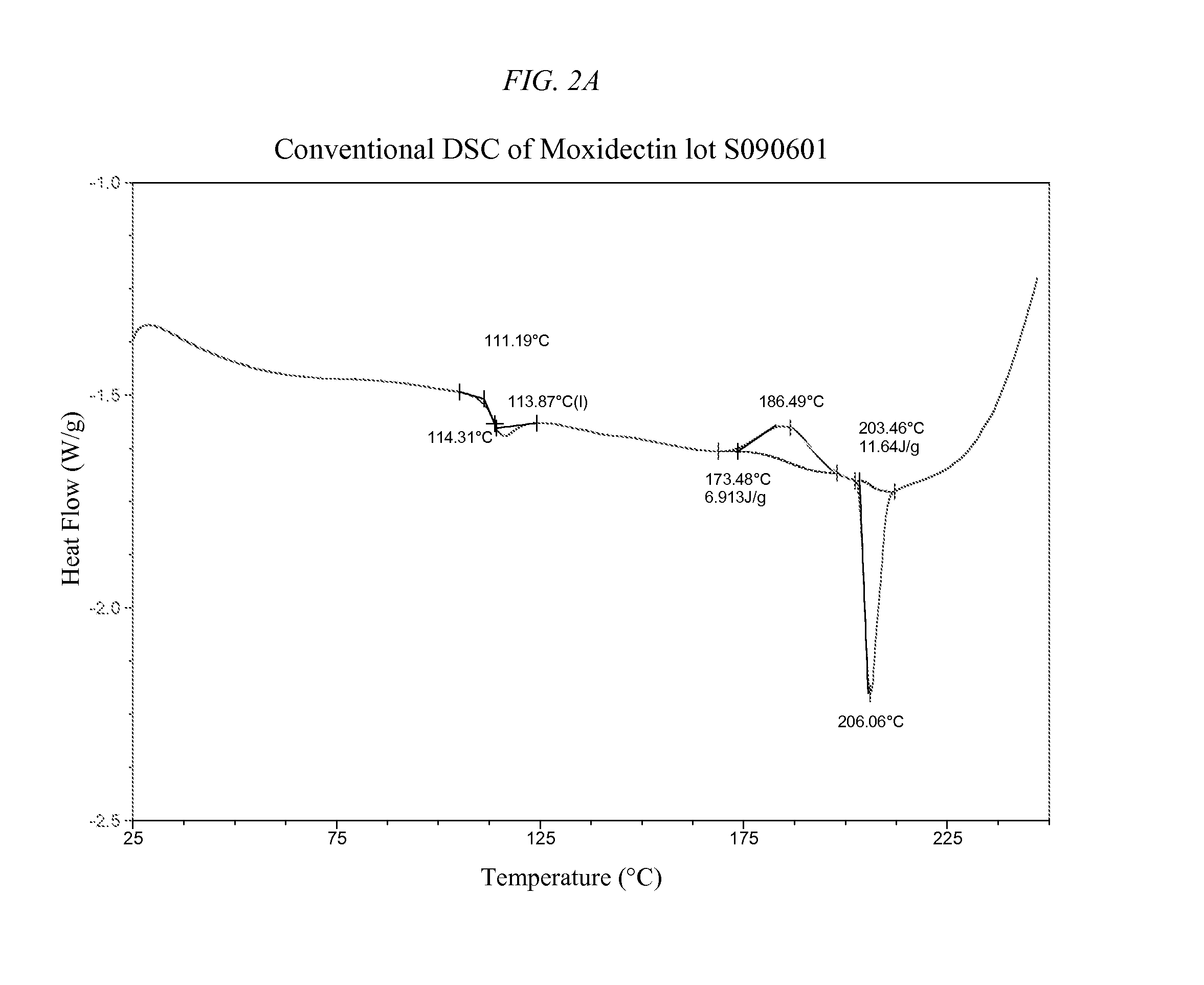Long-acting injectable moxidectin formulations and novel moxidectin crystal forms
a technology of moxidectin and crystal forms, which is applied in the direction of antiparasitic agents, biocides, drug compositions, etc., can solve the problems of severe economic losses in pigs, sheep, horses, cattle,
- Summary
- Abstract
- Description
- Claims
- Application Information
AI Technical Summary
Benefits of technology
Problems solved by technology
Method used
Image
Examples
example 1
Production and Analysis of Moxidectin Crystalline Forms Methods
[0153]Differential Scanning Calorimetry (DSC).
[0154]The samples were subjected to three modes of testing with TA Instruments' Q100 to determine the thermal possibilities.
1.The Conventional DSC method was used involvingthe following steps:a)Equilibrate at 20° C. for 3 minutes.b)Ramp 10° C. / minute to 250° C.[HEAT]2.The Modulated DSC with the following sequence of steps:a)Equilibrate at 200° C.b)Modulate ± 1° C. every 60 seconds.c)Isothermal for 5 minutes.d)Ramp 50° C. per minute to 200° C.3.The Heat-Cool-Heat method at a higher temperature range:a)Equilibrate at 20° C. for 3 minutes.b)Ramp 10° C. / minute to 200° C.[HEAT]c)Ramp 10° C. / minute to 20° C.[COOL]d)Ramp 10° C. / minute to 250° C.[HEAT]
[0155]Thermal Gravity Analysis (TGA).
[0156]TGA was performed on Perkin Elmer Pyris 1 TGA instrument. Samples were equilibrated at 22° C. for 1 minute, then heat was applied at ramp of 10° C. / minute to 300° C.
example 2
Preparation of Slow-Release Polymeric Implants Comprising Moxidectin, and In Vitro Release Profiles
[0213]Summary.
[0214]The crystal form properties of moxidectin API are depicted in FIGS. 2-8 and 10-12: including glass transition temperature, crystallization and the crystal melt. Polymeric implants containing either amorphous or crystalline moxidectin were prepared. For amorphous moxidectin implants, the process temperature was kept between ˜120-170° C. Inventors envision that any temperature above 120° C. (but below moxidectin's decomposition temperature) would be acceptable as the moxidectin would flow above its glass transition temperature and would be more easily extruded with increasing temperature (i.e. from 120 to 170° C.). The inventors found surprisingly and unexpectedly that moxidectin crystallizes above 170° C. Thus, there is a narrow temperature range that is optimal for preparation of the inventive implants, and processing at a temperature higher than re-crystallization ...
example 3
Moxidectin Plasma Profile in Canines Injected with Polymeric Implants
[0218]On Day 0, five canine animals were administered subcutaneously one injection of 4 implants (containing 2000 mcg amorphous moxidectin, 75:25 DLG (0.4 i.v.), prepared as above-lot#438-148), a separate implant needle containing the appropriate number of implants was used for each treated animal. Blood samples (approximately 5 to 7 mL) were collected in individually labeled heparinized tubes. Plasma was recovered and stored frozen in aliquots, until required for assay. Canine study data results are shown in FIG. 46. Additionally, implant samples were also assayed by DSC and IR which determined that Moxidectin was amorphous in the implant.
PUM
 Login to View More
Login to View More Abstract
Description
Claims
Application Information
 Login to View More
Login to View More - R&D
- Intellectual Property
- Life Sciences
- Materials
- Tech Scout
- Unparalleled Data Quality
- Higher Quality Content
- 60% Fewer Hallucinations
Browse by: Latest US Patents, China's latest patents, Technical Efficacy Thesaurus, Application Domain, Technology Topic, Popular Technical Reports.
© 2025 PatSnap. All rights reserved.Legal|Privacy policy|Modern Slavery Act Transparency Statement|Sitemap|About US| Contact US: help@patsnap.com



